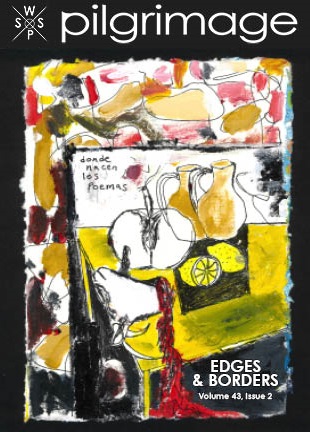 WELCOME WELCOME
We are pleased to finally present the latest issue of Pilgrimage, “Edges and Borders,” despite all
the delays. This has been an issue long in the making, and we are excited to share it with you.
Here at Colorado State University Pueblo, the pandemic created countless challenges and
we've undertaken adjustments to determine how we best move forward and stay afloat. For our
contributors that have waited a long time—we appreciate your patience and we hope this issue
is a proper celebration of your work. Your words carry so much inspiration, and we are honored
to feature you and your writing.
The issue’s theme came about when San Antonio poet and artist Octavio Quintanilla submitted
his artwork along with an introductory essay by Jim LaVilla-Havelin. Quintanilla’s frontextos are
“a combine of ‘frontera’ and ‘texto’” and a mixing of words and images. His art is an appropriate
entry into edges and borders, not only because of its Borderland placement, but also with his
use of mixed media to let the words, art, and language converge.
In Issue 30, Volume 2, we focused on The Borderlands, and we continue to feel the geography
where Mexico and the United States touch and grate. Richard Yañez and Yasmin Ramirez
teach us about El Chuco Love and ways to understand La Frontera while driving and admiring
their busy city after the tragic El Paso Walmart shooting in 2019. Especially now, this path
toward healing is how we carry our communities within us.
Language is a bridge we find in Rene Villanueva’s poem “Ni Esto / Ni Eso” and it is also the
“threat of barbed wire strung through the woods behind us” in Michele Waering’s poetry. We
speak the many tongues and play on the page, like those not allowed to speak their mother
tongue in the not so distant past. Similarly, the “/” guides us through the poems of Misael
Osorio-Conde, the blank spaces hold purgatory in Sean Cho A.’s poetry, and our latest
translation folio says hello to death, the first quarter moon, and a sunset in Dutch, Russian, and
Oriya.
And through sharp edges and the crossing of these borders, we challenge our comfort and we
travel. We chase the ghost of John Muir along hiking trails, we jump through time with Franz
Jørgen Neuman’s “Valley of the Dogs,” we wander through an Old Jewish Cemetery in Berlin,
we send “Postcards from the Andes,” we find “The Goat That Ate the Can,” we visit La Mitad del
Mundo in Quito, and we take the quest to buy a gallon of milk with J.D. Isip. All these works
represent the roots of Pilgrimage giving voice to travelers, wanderers, and dreams. Finally, we
have imagined encounters with shapeshifting fairies helping the rebels fight the tyrannical forces
in Yolanda Nieve’s “Prophecy,” and we witness the struggle of a couple trying to make love and
find privacy in an internment camp with Christopher Seiji Berardino’s story, “Silverblue.”
Ultimately, the theme and all the work in our issue guides us toward connections, survival, and
vital vulnerability. As written by Rhienna Renée Guedry, “The second thing about snakeskin is
this: remember you are not alone.” •
Juan Morales
Pueblo, CO
April 2022
|